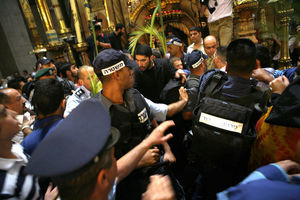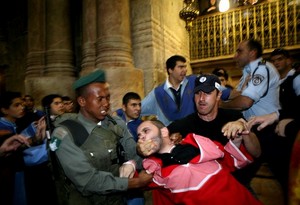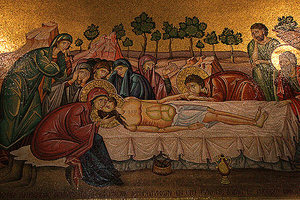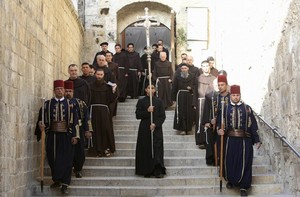|
 Armenian and Greek Orthodox monks clashed violently in the Church of the Holy Sepulchre on Sunday 9th November. Fighting erupted when Greek Orthodox monks blocked a procession of Armenian clergymen. The two Orthodox churches and the Custody of the Holy Land are resident in the Church under the terms of the ‘Status Quo’ agreement. Father Athanasius Macora (46, an US citizen) monitors the agreement on behalf of the Custody. He spoke with Terrasanta.net about the underlying reasons behind the clash, and what can be done to resolve long-standing tensions in the Church built over the place of Christ’s Crucifixion and Resurrection. Armenian and Greek Orthodox monks clashed violently in the Church of the Holy Sepulchre on Sunday 9th November. Fighting erupted when Greek Orthodox monks blocked a procession of Armenian clergymen. The two Orthodox churches and the Custody of the Holy Land are resident in the Church under the terms of the ‘Status Quo’ agreement. Father Athanasius Macora (46, an US citizen) monitors the agreement on behalf of the Custody. He spoke with Terrasanta.net about the underlying reasons behind the clash, and what can be done to resolve long-standing tensions in the Church built over the place of Christ’s Crucifixion and Resurrection.
What are your reflections on the recent clashes in the Church of the Holy Sepulchre?
The representatives of the Three Major Communities (the Custody of the Holy Land, the Greek Orthodox Patriarchate and the Armenian Patriarchate) have been meeting regularly about once a week or every ten days. In these meetings I negotiate on behalf of the Custody of the Holy Land all matters pertaining to the Status Quo, so I know exactly why it [the fight] happened. Now it’s not in my interest to say who was right and who was wrong. What set it off was that the Armenians have a Pontifical Procession and they objected to the presence of a Greek Sacristan inside the tomb during the procession. The Greeks claim to have the right to put a Greek Sacristan there.
Is this something that happens every year?
No it started one year ago. Since then, of course, there have been four such Armenian Pontifical Processions; there were problems with each one, but in this one, things kind of came to a head.
Why this one in particular?
The pressure had built up, because the problem was unresolved. There was no
 compromise by the two parties – whether the Greek sacristan should or shouldn’t be inside the Tomb. Here, what rules is the custom, what was happening before – in other words, what the practice was. Is there a Greek Sacristan inside or not? That is the question. So the Armenians blocked the tomb to prevent the Greeks from putting a guy inside, and the Greeks tried to put a guy inside and that’s when the fighting started. compromise by the two parties – whether the Greek sacristan should or shouldn’t be inside the Tomb. Here, what rules is the custom, what was happening before – in other words, what the practice was. Is there a Greek Sacristan inside or not? That is the question. So the Armenians blocked the tomb to prevent the Greeks from putting a guy inside, and the Greeks tried to put a guy inside and that’s when the fighting started.
What are the chances of this being resolved now, even after the fight?
We had a problem four years ago. We were attacked by the Greeks, quite a big attack. They also attacked the Police over something they had no right to do. After things settled down and there was another Greek procession in the near future, we presented our proofs in the presence of the Greeks to representatives of the Israeli government and police. The government has the obligation to enforce the prevailing Status Quo. We’re not necessarily asking the government to arbitrate. We’re asking the government to enforce. I provided sufficient proof: three video tapes from previous years showing how the Greek Procession was meant to take place, not through the Chapel of St. Mary Magdalen but by its side. The government then told the Greeks they had to do it in the proper way, and ever since then they have. Now both the Armenians and Greeks will have to furnish evidence to the government. There should be a meeting with all of them in the same room. It is not always easy however, to determine what is the prevailing status quo. You can demand that the government make a decision on it, to curtail the party that’s violating the Status Quo.
So that’s one way forward, you think?
What has to be understood is that for these communities every little thing is symbolic for them. So they don’t want to lose anything in the church. There’s a fear of compromise, everybody has maximal positions. I want to be fair here that this may not apply exactly to this situation, but both sides think they’re absolutely right.
 These kinds of tensions have been going on for years, as you say. But why is it such a difficult place for these different denominations to worship together in the Holy Sepulchre? These kinds of tensions have been going on for years, as you say. But why is it such a difficult place for these different denominations to worship together in the Holy Sepulchre?
The problem is this: the Status Quo is an imperial decree that was imposed by the Ottoman Turks on the communities. It’s not a code and this means there’s no clarity on certain issues. It’s a long story, but basically France was attempting to regain Catholic predominance in certain places such as the Holy Sepulchre. France was attempting to pressure the Ottomans while the Russians were pressuring the Ottomans on behalf of the Greeks. The Ottomans couldn’t deal with the situation. If they took France’s position or Russia’s position, they were in big trouble. So what they did was, they simply declared the Status Quo: everybody stays in his place. It’s a very short decree, maybe three pages long. It doesn’t define things, it simply says everyone has to stay in his place. Now because there were a lot of areas that were vague, the communities would enter into conflict over who got to clean, or repair something. These things indicated rights. For instance, we often object if the Coptic Orthodox go on too long during their prayers. If one of the communities prays over its allotted time, we object to it because it causes us to lose time in our schedule.
But it is, as you know, such a counter-witness isn’t it?
I’ve gotten to the point where I don’t like talking about it. There’s a good book out on the subject called Saving the Holy Sepulchre by Raymond Cohen. It’s a very good book and talks about very positive things, that basically since 1957 until 1997, the communities undertook extensive renovations and that more or less, let’s say, a strategic decision was taken on the part of the Greeks to work with the other communities. So the Three Major Communities did hammer out a lot of agreements, and a lot of things have been settled permanently. What happened on Sunday is really an anomaly. If you know the Status Quo well, and let’s say if I know it well, I’m going to insist where it’s my right to insist, and I’m not going to insist when I don’t have a right to insist. If one of the communities doesn’t know the way it works, then we’re going to have problems.
Do you foresee in the future that everyone will get along if perhaps there’s a Code that’s written up and people know where they stand?
I’m quoted in this book on the Holy Sepulchre as saying that my approach would be to codify everything. If you codify everything then you end disputes, everyone knows where they’re supposed to be. If they make a mistake then OK, it’s understood, it’s written down.
And what are the chances of that happening?
It’s not going to happen anytime soon. There was a chance of it happening a few years ago, but it depends on who the players are now.
 With the Franciscans having this great reputation of peace-making, do you think there is way that you could be the real protagonists of bringing peace to the Holy Sepulchre? With the Franciscans having this great reputation of peace-making, do you think there is way that you could be the real protagonists of bringing peace to the Holy Sepulchre?
I think that we can serve, we can help, but to make peace you need political will. You need to have the desire for peace. In the case of the Custody, we have a desire for it, but for the others, they have to see what is at stake. It’s better for us to finish with all these issues and be a proper witness rather than continue fighting over this – I mean one sacristan in or out of the Tomb is a relatively small issue if it only happens four times a year. It doesn’t change significantly one’s rights but because everything in the Church is so highly symbolic, every a tiny thing becomes a major issue.
As Franciscans we basically enjoy good relations with both sides. We hope to get back to work, we hope they can reconcile and move on, and we hope this doesn’t happen again because it’s very negative. It got a lot of press. It was extremely damaging what happened.
But you’re hopeful all sides can come together in the long run?
Yes, we have common projects going on. We’re actually working on things right now, so we are cooperating but this was something that was unfortunate.
(courtesy of Terrasanta.net)
|


